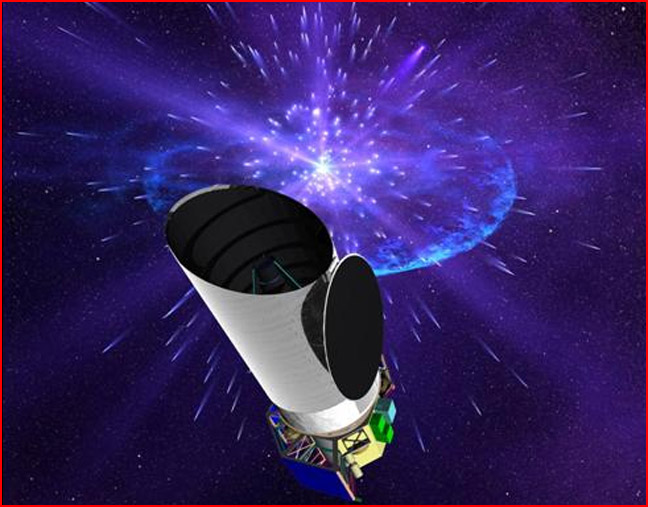
home •
about •
essential guide •
picture of the day •
thunderblogs •
news •
multimedia •
predictions •
products •
get involved •
contact
picture of the day archive subject index
An artist’s concept of the Destiny spacecraft at work. Image Credit: NASA/GSFC
Feb 12, 2007
Astronomers Stumble Over Assumptions
NASA now plans to proceed with the Destiny space mission to analyze Dark Energy. But according to critics, the validity of the mission itself rests entirely on blind faith.
“They apply a blind eye to the wrong end of the telescope and tell us what they imagine they see.” –Wallace Thornhill
With the confidence that comes from taking one’s assumptions for granted, NASA has chosen to spend taxpayers’ money on the development of a space telescope dedicated to discovering the properties of unseen Dark Energy.
Having concluded that the Universe is strongly affected by Dark Energy and that it constitutes a large proportion of the "missing mass", astronomers say it is now time to investigate in more detail how it works. Critics, however, see Dark Energy as a convenient fiction that masks the failure of astronomers’ physics and assumptions—in particular the assumptions that energy and matter are equivalent and that gravity alone drives the universe.
Of course, the telescope can’t see Dark Energy. It will actually observe supernovae. These are the same supernovae observations that in the 1990s, according to NASA’s press release, “forced [astronomers] to conclude that the Universe contains … Dark Energy ….” Further observations at “near-infrared wavelengths [will] measure how the large-scale distribution of matter in the Universe has evolved since the Big Bang.”
Taxpayers may suppose that looking with the same blind eye through the same end of a new, more expensive telescope will refine the imagined view of the exotic, unseen, and ever-elusive energy. But the conclusion that Dark Energy exists was forced by the logic of unquestioned assumptions and creed-bound observations. The theorized existence of Dark Energy depends on a long list of such assumptions:
IF stars are isolated self-gravitating objects
IF stars are powered by internal thermonuclear fusion
IF electrical forces can be neglected
IF the “K effect” (anomalous redshift of the brightest stars) can be ignored
IF stars evolve to a supernova condition
IF matter can be compressed to a superdense state
IF supernovae are “standard candles” (all have the same absolute brightness)
IF intervening dimming from absorption is known
IF redshift is proportional to distance (if the Universe is actually expanding)
IF the (observable) Universe is not composed mostly of plasma
IF near-infrared emission indicates large-scale distribution of matter
IF the distribution of matter matters (Mass is the primary quality only for the Big Bang. In a plasma universe, the distribution of Birkeland currents matters more — and that is better indicated by radio telescopes and x-ray mapping.)
IF the principle of "no creation from nothing" can be ignored. Otherwise dark energy cannot account for the predominantly "missing mass" of the universe.
The “IFs” can be counted as “knowns” only as the fervor of belief can exclude doubts and the principles of physics can be ignored. Although the “IFs” may be touted as objective facts, they are better called objectified foci of fervency.
Astronomer Halton Arp and others have shown in a myriad of observations that objects with different redshifts are statistically associated, physically connected, and genetically related. Within connected groups of galaxies, those with the highest excess redshifts “have strikingly less luminous stars than other companion galaxies.” High-redshift galaxies are disproportionately “peculiar”; they appear small and faint not because they are far away but because they really are small and faint; and their supernovae are proportionally fainter than those in mature galaxies.
The standard mapping of the Universe that sets distance proportional to redshift and luminosity requires an accelerating expansion, and therefore Dark Energy, to propel the acceleration, because the density of objects we see decreases as we look at larger and brighter objects. The few big and bright galaxies eject many small and faint “blobs,” some of which evolve into larger and brighter companion galaxies. The entire process is taking place right before our eyes … IF we pull away the wool of obsolete assumptions.
A plasma universe does not need Dark Energy or "missing mass" … any more than we need further waste of tax revenues.
Contributed by Mel Acheson
![]()
home •
thunderblogs •
forum •
picture of the day •
resources •
team •
updates •
contact us
EXECUTIVE EDITORS:
David Talbott, Wallace Thornhill
MANAGING EDITORS:
Steve Smith, Mel Acheson
CONTRIBUTING EDITORS: Michael Armstrong, Dwardu Cardona,
Ev Cochrane,
C.J. Ransom, Don Scott, Rens van der Sluijs, Ian Tresman
WEBMASTER: Brian Talbott
Copyright 2007: thunderbolts.info
